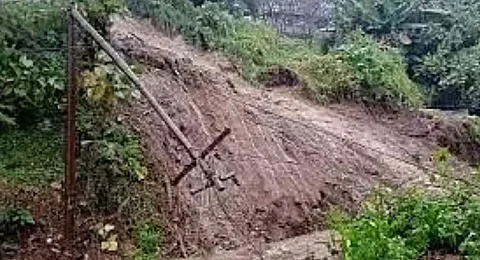
- Home
- Live Blog
- Breaking News
- Top Headlines
- Cities
- NE News
- Sentinel Media
- Sports
- Education
- Jobs

STAFF REPORTER
GUWAHATI: The monsoon comes to Assam with a price, and that is landslides. The State Government has already mapped the landslide-prone areas in Guwahati way back in 2015 but has stopped short of putting in place a preventive mechanism even today. This leads to the killing of humans due to landslides. The Kamrup (Metro) district administration has issued notices to around 200 families in Guwahati, asking them to move to safer areas.
According to official sources, from 2016 to 2022, Assam lost 79 human lives due to landslides, with around half of them in Guwahati. “Unplanned and illegal settlements in the hills have caused deadly landslides. The need of the hour is to have a proper mechanism to prevent landslides,” an official said.
What has happened over the years on this front is that the District Disaster Management Authorities (DDMAs) wash their hands just by issuing notices to the people residing in landslide-prone areas before the monsoon, asking them to vacate their houses. While some of the residents obey the stricture, others do not. After the monsoon, everything is back to square one: the residents go back to their houses in the landslide-prone areas under the very noses of the administrations.
The Government made the Assam Engineering College (AEC) and Assam State Disaster Management Authority (ASDMA) conduct a survey of the 19 hills in and around Guwahati in 2015. The survey found 366 spots that were landslide-prone in the city. After that, illegal settlements in hills have gone up manifold, as has the number of landslide-prone areas. In 2015, the survey spotted 20 areas in Santipur, 40 in Noonmati, 30 in Hengrabari, 37 in Kharghuli, 14 in Narakasur, eight in Maligaon, five in Fatasil, 77 in Sunsali, etc., as landslide-prone.
According to sources, settlers resort to earth-cutting and erecting guard walls without any monitoring from the authorities on the size and mechanism of such guard walls, which often collapse. The neighbours downstream often resort to steep earth-cutting close to such guard walls to erect houses. This practice leads to fatal accidents when guard walls collapse.
The moot question is: what makes the government desist from evicting the people residing in the identified landslide-prone areas? If the government can evict people residing on wetlands like Silsako Beel and on forest land, why cannot it do the same to those residing in landslide-prone areas? If there are any genuine landless people among such settlers, the government needs to provide them with land elsewhere.
Also WATCH: